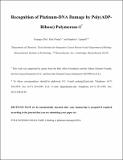Recognition of Platinum−DNA Damage by Poly(ADP-ribose) Polymerase-1
Author(s)
Zhu, Guangyu; Chang, Paul; Lippard, Stephen J.
DownloadZhu et al Biochemistry.pdf (1.835Mb)
PUBLISHER_POLICY
Publisher Policy
Article is made available in accordance with the publisher's policy and may be subject to US copyright law. Please refer to the publisher's site for terms of use.
Terms of use
Metadata
Show full item recordAbstract
Poly(ADP-ribose) polymerase-1 (PARP-1) was recently identified as a platinum−DNA damage response protein. To investigate the properties of binding of PARP-1 to different platinum−DNA adducts in greater detail, biotinylated DNA probes containing a site-specific cisplatin 1,2-d(GpG) or 1,3-d(GpTpG) intrastrand cross-link or a cisplatin 5′-GC/5′-GC interstrand cross-link (ICL) were utilized in binding assays with cell-free extracts (CFEs) in vitro. The activated state of PARP-1 was generated by treatment of cells with a DNA-damaging agent or by addition of NAD+ to CFEs. PARP-1 binds with a higher affinity to cisplatin-damaged DNA than to undamaged DNA, and the amount of protein that binds to the most common cisplatin−DNA cross-link, 1,2-d(GpG), is greater than the amount that binds to other types of cisplatin−DNA cross-links. Both DNA damage-activated PARP-1 and unactivated PARP-1 bind to cisplatin-damaged DNA, and both automodified PARP-1 and cleaved PARP-1 bind to cisplatin−DNA lesions. The role of poly(ADP-ribose) (pADPr) in mediating binding of PARP-1 to platinum damage was further investigated. The extent of binding of PARP-1 to the cisplatin 1,2-d(GpG) cross-link decreases upon automodification, and overactivated PARP-1 loses its affinity for the cross-link. Elimination of pADPr facilitates binding of PARP-1 to the cisplatin 1,2-d(GpG) cross-link. PARP-1 also binds to DNA damaged by other platinum compounds, including oxaliplatin and pyriplatin, indicating protein affinity for the damage in an adduct-specific manner rather than recognition of distorted DNA. Our results reveal the unique binding properties for binding of PARP-1 to platinum−DNA damage, providing insights into, and a better understanding of, the cellular response to platinum-based anticancer drugs.
Date issued
2010-06Department
Massachusetts Institute of Technology. Department of Chemistry; Koch Institute for Integrative Cancer Research at MITJournal
Biochemistry
Publisher
American Chemical Society
Citation
Zhu, Guangyu, Paul Chang, and Stephen J. Lippard. “Recognition of Platinum−DNA Damage by Poly(ADP-ribose) Polymerase-1.” Biochemistry 49.29 (2010) : 6177-6183.
Version: Author's final manuscript
ISSN
0006-2960
1520-4995